Question
1. A diversified company has decided to use its overall firm WACC as a performance benchmark for rating its divisional managers and to decide whether
1. A diversified company has decided to use its overall firm WACC as a performance benchmark for rating its divisional managers and to decide whether new projects from its three divisions should be funded for investment capital. The firm WACC is 12%. The divisional WACCs for its high risk, average risk, and low risk divisions are 16%, 11.9%, and 8%, respectively. Please explain the pros and cons of using the firm WACC in evaluating its divisional managers and projects.Remember that WACC can be interpreted as a hurdle rate or the minimum acceptable return. Limit your answers to no more than 10 sentences
2.Finance research has shown that managers of actively managed mutual funds or exchange traded funds (ETF), on average, do notoutperform the overall stock market as measured by the S&P 500 index (see chapter 7 PP slides and your book). In some years, more than 80% of fund managers were unable to beat the overall stock market. The year 2013 is a good example when the S&P 500 yielded nearly 29% return, which was better than the average return on 95% of actively managed stock prortfolios with similar risk. (a) If you believe these results which seem to support informational efficiency of equity markets in U.S., what would be your investment strategy so that youraveragelong-runreturns are better than the returnsrealized by more than two-third (75%) of professional money managers of actively traded funds. Explain. (b) If equity markets are efficient and rational to alarger extent, how would you explainthe stock market bubble of 2008 in the presence of efficient markets.Please limit your answers to no more than twenty (20) sentences.
3.You recently learned in FIN 602 how to value stocks using the P/E multiples approach, constant dividend growth model, and corporate valuation model. On September 24, 2015, you tuned into CNBC financial TV channel and watch different security analysts discussing the current valuations of Amazon, Apple, Google, Facebook, Goldman Sachs, and the overall U.S., European, emerging stock markets .However, you are puzzled because these analysts could not agree on the current valuations and end-of-year price targets for the four companies and overall stock market. For example, two analysts argued that Apple and Goldman Sachs (an investment bank) are currently overvalued, while others reached the opposite conclusion. Their end-of-the-year stock price targets also varied widely.Please solve this puzzle and explain how these analysts can reach such very different conclusions on stock valuations and price targets.Limit your answers to no more than 10 sentences
Step by Step Solution
There are 3 Steps involved in it
Step: 1

Get Instant Access to Expert-Tailored Solutions
See step-by-step solutions with expert insights and AI powered tools for academic success
Step: 2

Step: 3

Ace Your Homework with AI
Get the answers you need in no time with our AI-driven, step-by-step assistance
Get Started


